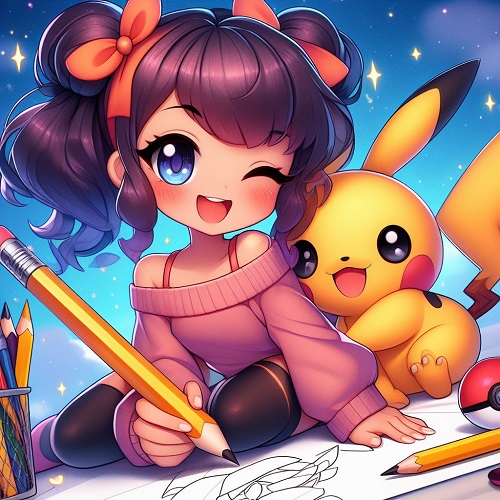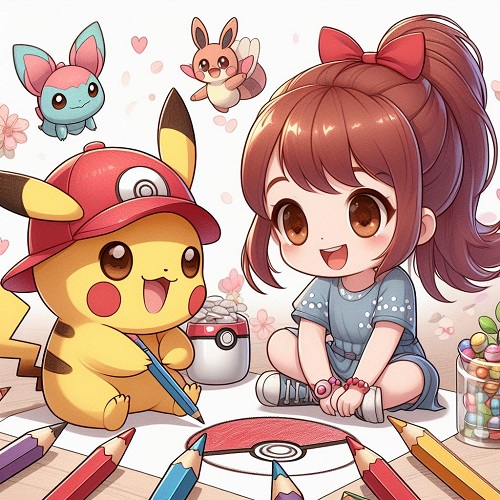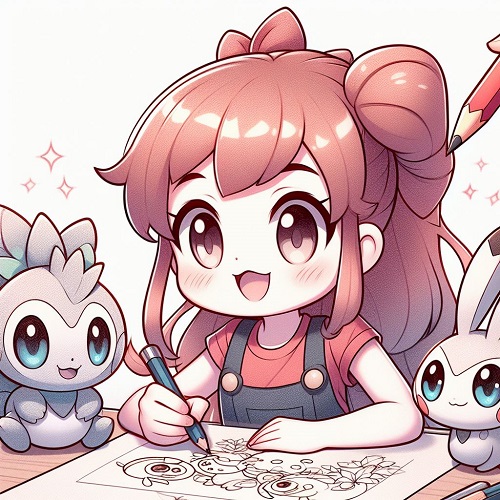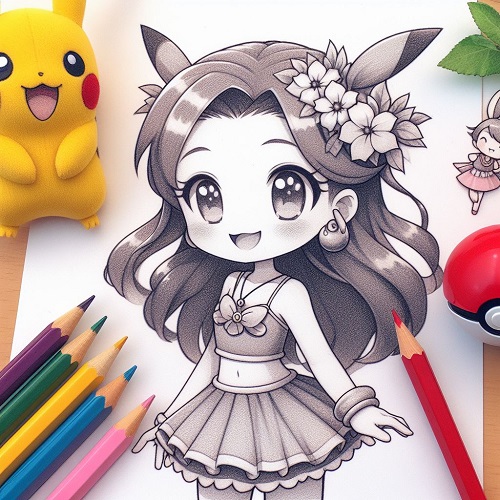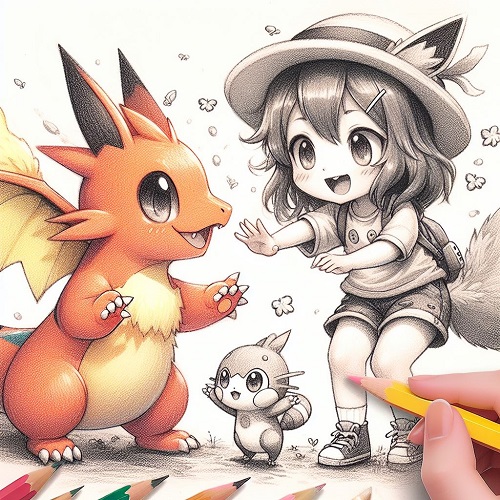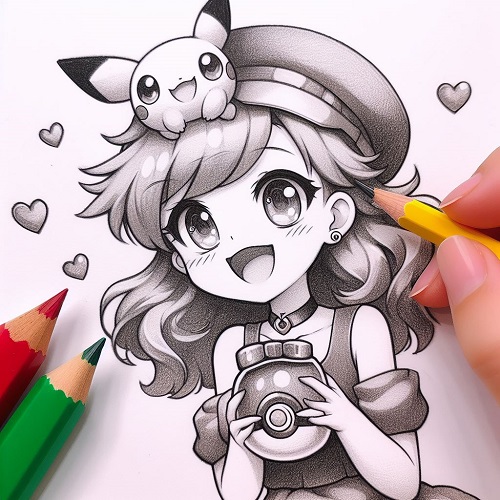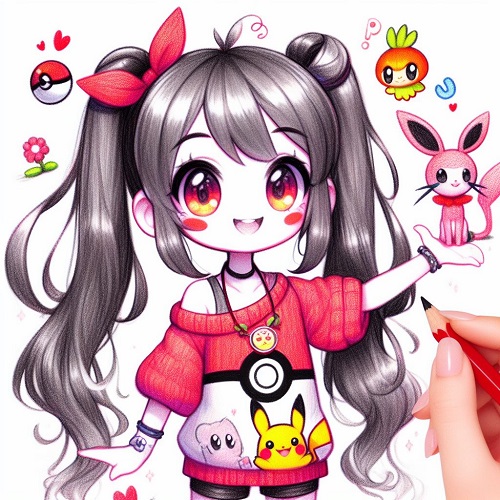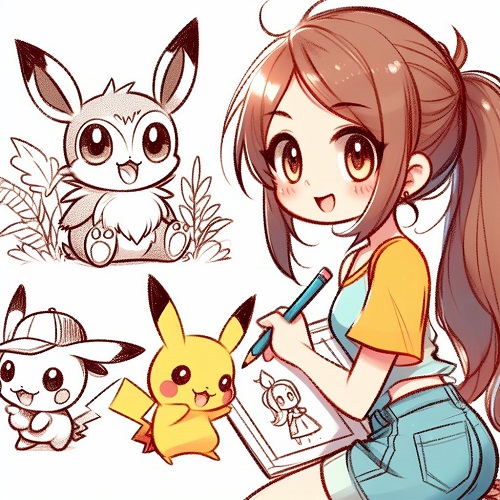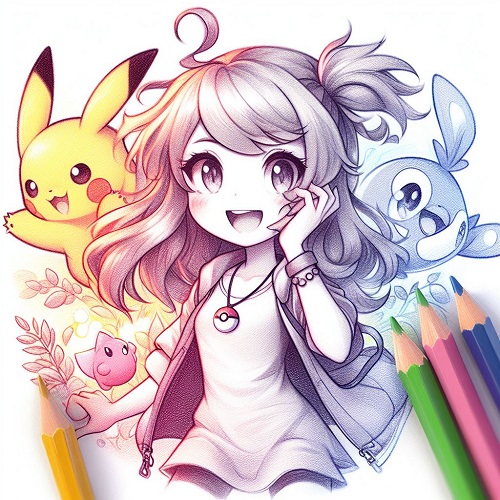Mastering the Art: A Comprehensive Guide to Pokemon Pencil Drawing
Welcome to the enchanting universe of Pokemon pencil drawing! Whether you’re a seasoned artist or just starting your creative journey, this comprehensive guide is here to help you unravel the secrets behind crafting captivating Pokemon artworks using the timeless medium of pencil and paper.
A. Brief Overview of the Pokemon Franchise
The Pokemon franchise, a global phenomenon, has captured the hearts of millions since its inception. With a rich tapestry of characters, each Pokemon possesses unique traits, making them the perfect subjects for artistic expression. This guide will explore how to harness the power of pencil drawing to bring these iconic creatures to life on paper.
B. The Rise of Pokemon Fan Art
As the Pokemon community continues to grow, so does the vibrant world of Pokemon fan art. Artists worldwide showcase their interpretations of these beloved characters through various mediums, with pencil drawing remaining a classic and cherished approach. This guide will equip you with the skills needed to contribute your unique vision to this ever-expanding artistic landscape.
C. Importance of Pencil Drawing in Capturing the Essence
Pencil drawing, with its tactile nature and nuanced shading possibilities, allows artists to delve into the intricacies of each Pokemon’s design. This guide aims to demonstrate how the simplicity of pencil and paper can be a powerful tool in capturing the essence and personality of your favorite Pokemon.
Getting Started with Pokemon Pencil Drawing
1. Essential Tools and Materials
FAQ:
Q: What types of pencils are best for Pokemon pencil drawing?
A: A range of pencils, from 2H for light sketching to 6B for darker shading, offers versatility in capturing different Pokemon characteristics.
Q: How do I choose the right sketching paper?
A: Opt for acid-free, heavyweight paper to ensure durability and prevent yellowing over time.
Q: Are there any digital tools recommended for reference materials?
A: While digital references can be useful, having physical Pokemon cards or printed images can provide a tangible connection during the drawing process.
2. Understanding Pokemon Anatomy
FAQ:
Q: Is it necessary to memorize the anatomy of all Pokemon?
A: While memorization helps, reference materials and a deep understanding of basic anatomy principles can guide you in drawing any Pokemon convincingly.
Q: How do I approach Pokemon with complex designs?
A: Break down intricate designs into simpler shapes and focus on mastering one section at a time to maintain accuracy.
Q: Can I take creative liberties with Pokemon anatomy?
A: Absolutely! While accuracy is crucial, adding personal flair can make your drawings unique and expressive.
3. Tips for Capturing Unique Features
FAQ:
Q: How do I emphasize distinct features like Pikachu’s tail or Jigglypuff’s eyes?
A: Pay meticulous attention to details and use varying pencil pressures to create emphasis without overpowering the rest of the drawing.
Q: Any tips for handling Pokemon with unconventional shapes?
A: Break down complex shapes into basic geometric forms to ensure accurate representation and proportion.
Q: Should I prioritize accuracy over creativity?
A: Strive for a balance between accuracy and creative interpretation to make your drawings stand out while remaining recognizable.
4. Importance of Paying Attention to Details
FAQ:
Q: How do I avoid overwhelming my drawing with too many details?
A: Prioritize essential features and gradually add details, ensuring they contribute to the overall cohesion of the drawing.
Q: Can I use shading to convey details instead of lines?
A: Absolutely. Experiment with different shading techniques to convey textures and details subtly.
Q: How do I know when a drawing has enough details?
A: Step back periodically and assess your progress. A well-balanced drawing has enough details to captivate the viewer without feeling cluttered.
Sketching Techniques for Pokemon
5. Basic Sketching Guidelines
FAQ:
Q: Should I start with a rough sketch or go straight into detailing?
A: Begin with a light, rough sketch to establish proportions and composition before diving into details.
Q: How do I avoid smudging while sketching?
A: Use a scrap piece of paper under your hand to minimize contact with the drawing surface, and consider using fixative spray on finished sketches to prevent smudging.
Q: Can I use mechanical pencils for sketching?
A: Yes, but traditional wooden pencils offer more versatility in shading and line variation.
6. Building the Foundation with Light Lines
FAQ:
Q: Why is it essential to start with light lines?
A: Light lines allow for easy adjustments and corrections as you refine the overall structure of your drawing.
Q: Should I erase the initial light lines once the drawing progresses?
A: Yes, gradually replace light lines with darker, refined lines as you solidify the details to maintain a clean and polished appearance.
Q: How do I avoid overworking the initial sketch?
A: Step back frequently to evaluate your progress and avoid unnecessary detailing before the overall structure is in place.
7. Tips for Achieving Proportion and Balance
FAQ:
Q: What if I struggle with getting proportions right?
A: Use measuring techniques, such as comparing sizes and angles, and don’t hesitate to adjust as needed during the drawing process.
Q: How do I maintain balance in dynamic poses?
A: Establish a strong foundation in the center of gravity and consider using supporting elements like tails or wings to maintain balance.
Q: Can I take creative liberties with proportions?
A: While creativity is encouraged, maintaining recognizable proportions is crucial for a faithful representation of the Pokemon.
Shading and Texturing
8. Exploring Different Shading Techniques
FAQ:
Q: What shading technique works best for Pokemon drawings?
A: Experiment with hatching, cross-hatching, and stippling to find the technique that complements the texture and mood of each Pokemon.
Q: How do I decide where to place shadows?
A: Understand the light source in your drawing and imagine how it interacts with the Pokemon’s form to determine shadow placement.
Q: Can I combine different shading techniques in one drawing?
A: Absolutely. Mixing shading techniques adds depth and visual interest to your Pokemon drawings.
9. Adding Depth and Dimension
FAQ:
Q: How do I make Pokemon drawings look three-dimensional?
A: Vary your shading intensity, with lighter shades for areas receiving more light and darker shades for shadowed regions, to create a sense of depth.
Q: Should I prioritize texture or depth in my shading?
A: Balance both elements, considering the Pokemon’s characteristics and the overall mood you want to convey.
Q: Any tips for shading transparent or translucent Pokemon?
A: Use subtle shading and pay attention to the edges to create the illusion of transparency without compromising the Pokemon’s form.
10. Creating Realistic Textures
FAQ:
Q: How can I replicate fur textures in pencil drawings?
A: Use short, controlled strokes to mimic fur texture, adjusting the length and direction based on the Pokemon’s fur type.
Q: Tips for drawing smooth, reflective surfaces like water?
A: Achieve a smooth and reflective surface by incorporating gentle shading, paying attention to the direction of the light source, and adding subtle highlights to enhance the reflective effect.
Q: Can I use erasers to create textures in my drawings?
A: Yes, experiment with different erasers to lift off pencil lines selectively, creating highlights and adding texture to your Pokemon drawings.
Bringing Pokemon to Life
11. Techniques for Adding Expression and Emotion
FAQ:
Q: How do I convey a specific emotion in a Pokemon’s expression?
A: Focus on the eyes, eyebrows, and mouth to convey emotions effectively. Experiment with variations to capture the desired mood.
Q: Should I use exaggerated expressions for more impact?
A: While exaggeration can be effective, subtle changes in expression can also convey a wide range of emotions. Strike a balance based on the Pokemon’s personality.
Q: Tips for conveying complex emotions in Pokemon with limited facial features?
A: Utilize body language, posture, and the positioning of appendages to convey emotions in Pokemon with minimal facial expressions.
12. Importance of Conveying Personality
FAQ:
Q: How do I ensure my drawing accurately reflects a Pokemon’s personality?
A: Study the Pokemon’s lore, animations, and characteristics to understand its personality traits. Infuse these traits into your drawing through pose, expression, and overall composition.
Q: Can I take creative liberties with a Pokemon’s personality?
A: Absolutely. While staying true to the source material is essential, adding your interpretation and personality to the Pokemon can make your artwork unique.
Q: Tips for maintaining consistency in portraying a Pokemon’s personality across different drawings?
A: Create a character sheet for each Pokemon you draw, noting key personality traits and visual features to ensure consistency in your artistic interpretations.
13. Tips for Achieving Dynamic Poses
FAQ:
Q: How can I make my Pokemon drawings more dynamic?
A: Experiment with dynamic poses by studying action poses in real-life references or dynamic scenes from the Pokemon series to inject energy into your drawings.
Q: Can I use exaggerated perspectives for added dynamism?
A: Yes, but ensure the exaggeration serves the narrative and personality of the Pokemon rather than feeling forced or unnatural.
Q: Any tips for conveying motion in static drawings?
A: Use flowing lines, varying line weights, and implied motion lines to give the illusion of movement and action within a still drawing.
Advanced Pokemon Drawing Tips
14. Incorporating Backgrounds and Environments
FAQ:
Q: How important are backgrounds in Pokemon drawings?
A: Backgrounds provide context and depth to your drawings. Experiment with simple settings or more elaborate environments to enhance the overall visual narrative.
Q: Tips for choosing backgrounds that complement Pokemon drawings?
A: Consider the Pokemon’s habitat, type, and characteristics when selecting or creating backgrounds. Ensure the background enhances rather than detracts from the main subject.
Q: Can I use digital tools for creating backgrounds?
A: Absolutely. Combining traditional pencil drawings with digital backgrounds can provide a polished and visually striking result.
15. Experimenting with Different Perspectives
FAQ:
Q: How do different perspectives enhance Pokemon drawings?
A: Exploring various perspectives adds visual interest, allowing viewers to appreciate the Pokemon from unique angles. It also demonstrates versatility in your artistic skills.
Q: Any tips for maintaining consistency in perspectives across a series of drawings?
A: Create a visual theme or motif that ties your drawings together, ensuring consistency while still allowing for varied perspectives.
Q: Should I prioritize accuracy over creativity when experimenting with perspectives?
A: Balance both elements. While accuracy is important, don’t shy away from creative perspectives that showcase your artistic vision.
16. Utilizing Advanced Shading and Lighting Techniques
FAQ:
Q: How do I master advanced shading techniques?
A: Practice regularly, study the works of accomplished artists, and experiment with different pencil pressures, blending, and layering techniques to achieve nuanced shading.
Q: Tips for creating realistic lighting effects in Pokemon drawings?
A: Understand the direction and intensity of the light source. Pay attention to cast shadows, highlights, and ambient lighting to create a convincing lighting environment.
Q: Can I use colored pencils or blending stumps for advanced shading?
A: Yes, incorporating colored pencils or blending stumps can enhance your shading and provide a wider range of tones in your Pokemon drawings.
Showcasing Your Pokemon Art
17. Importance of Creating a Portfolio
FAQ:
Q: Why is a portfolio essential for Pokemon artists?
A: A portfolio serves as a visual resume, showcasing your skills, artistic evolution, and range of Pokemon drawings. It’s a valuable tool for self-promotion and attracting potential opportunities.
Q: What should I include in my Pokemon art portfolio?
A: Curate a diverse selection of your best Pokemon drawings, demonstrating your proficiency in various styles, techniques, and subjects. Include personal projects, commissioned work, and any relevant collaborations.
Q: Can I include works in progress (WIPs) in my portfolio?
A: Yes, including WIPs provides insight into your creative process, demonstrating your dedication to improvement and willingness to share your artistic journey.
18. Sharing Your Work on Social Media
FAQ:
Q: Which social media platforms are best for sharing Pokemon drawings?
A: Platforms like Instagram, Twitter, and DeviantArt are popular choices for sharing Pokemon art. Choose platforms that align with your target audience and artistic goals.
Q: How often should I post my Pokemon drawings on social media?
A: Find a posting schedule that works for you, aiming for consistency without sacrificing the quality of your content. Regular engagement helps build an audience and community.
Q: Any tips for engaging with followers and fellow artists on social media?
A: Respond to comments, participate in art challenges, and share insights into your artistic process. Building genuine connections fosters a supportive and interactive community.
19. Engaging with the Pokemon Fan Art Community
FAQ:
Q: How can I become an active part of the Pokemon fan art community?
A: Join forums, groups, or Discord communities dedicated to Pokemon fan art. Participate in discussions, share your work, and appreciate the work of fellow artists.
Q: Is constructive criticism beneficial in the fan art community?
A: Absolutely. Constructive criticism helps artists grow and improve. Be open to feedback, and when offering criticism, focus on positive aspects while suggesting areas for enhancement.
Q: Can collaborations with other artists enhance my presence in the community?
A: Yes, collaborating with other Pokemon artists provides opportunities for shared exposure, creativity, and the chance to learn new techniques and approaches.
Common Mistakes and How to Avoid Them
20. Overcoming Challenges in Pokemon Pencil Drawing
FAQ:
Q: What is the most common challenge faced by Pokemon artists?
A: One common challenge is achieving accurate proportions. Practice measuring and comparing sizes regularly to improve your sense of proportion.
Q: How do I overcome creative block during the drawing process?
A: Take breaks, seek inspiration from other art forms, and explore new mediums or subjects. Sometimes, stepping away from your work momentarily can lead to fresh perspectives upon your return.
Q: Is it common to struggle with drawing specific Pokemon species?
A: Yes, certain Pokemon may pose challenges due to their unique features. Break down the drawing into manageable sections, focusing on one aspect at a time to overcome difficulties.
21. Learning from Mistakes and Improving Skills
FAQ:
Q: How do I approach learning from mistakes without becoming discouraged?
A: Embrace mistakes as valuable learning opportunities. Analyze what went wrong, and view each mistake as a step towards improvement rather than a setback.
Q: Should I revisit old drawings to assess my progress?
A: Absolutely. Revisiting old drawings allows you to appreciate your growth, identify areas for improvement, and gain a renewed perspective on your artistic journey.
Q: How do I maintain a positive mindset when facing artistic challenges?
A: Cultivate a growth mindset by viewing challenges as opportunities for improvement. Celebrate small victories and focus on the progress you make with each drawing.
22. Troubleshooting Common Issues
FAQ:
Q: What if my pencil lines become too dark and overpower the drawing?
A: Gradually build up your shading in layers, starting with lighter lines and gradually increasing the darkness. This allows for better control and avoids overpowering the drawing.
Q: How can I prevent smudging when shading with pencils?
A: Place a clean sheet of paper under your hand to minimize contact with the drawing surface. Additionally, consider using fixative spray on finished drawings to prevent smudging.
Q: Is it normal to face difficulties with achieving realistic textures?
A: Yes, achieving realistic textures can be challenging. Experiment with various shading techniques, observe real-life textures, and practice incorporating them into your drawings.
Inspiring Pokemon Pencil Drawing Examples
23. Showcase of Exceptional Pokemon Pencil Drawings
Explore a curated collection of outstanding Pokemon pencil drawings that showcase diverse styles, techniques, and artistic approaches. From hyper-realistic interpretations to stylized and imaginative creations, let these examples ignite your creativity and inspire your unique artistic journey.
24. Highlighting Diverse Styles and Approaches
Celebrate the diversity within the Pokemon art community by exploring various styles and approaches. Whether you’re drawn to realism, cartoonish interpretations, or a blend of both, discover how different artists bring their own flair to the world of Pokemon.
25. Drawing Inspiration from Fellow Artists
Learn from your peers by studying their work, techniques, and creative processes. Discover how artists overcome challenges, experiment with styles, and inject their unique personalities into their Pokemon drawings. Drawing inspiration from others is a powerful way to fuel your creativity and broaden your artistic horizons.
Frequently Asked Questions
26. Addressing Common Queries from Aspiring Artists
Explore common questions posed by aspiring Pokemon pencil artists and receive comprehensive answers to guide you on your artistic journey. From inquiries about tools and techniques to questions about specific Pokemon features, find the information you need to enhance your skills.
27. Providing Solutions to Common Challenges
Discover practical solutions to frequently encountered challenges in Pokemon pencil drawing. Whether you’re struggling with anatomy, shading, or finding your artistic voice, these solutions will help you navigate obstacles and continue evolving as a proficient Pokemon pencil artist.
28. Encouraging Continued Learning and Improvement
Embrace the mindset of continuous learning and improvement as you embark on your Pokemon pencil drawing journey. Discover the joy of growth, the satisfaction of overcoming challenges, and the endless possibilities that come with honing your skills. This section serves as a motivational reminder to stay curious, inspired, and dedicated to your artistic development.
Conclusion
In conclusion, mastering the art of Pokemon pencil drawing is a rewarding journey that requires dedication, practice, and a passion for the Pokemon universe. By delving into the comprehensive guide presented here, you’ve gained valuable insights into essential techniques, advanced tips, and ways to navigate common challenges. Now, armed with knowledge and inspiration, embark on your artistic adventure, create captivating Pokemon artworks, and contribute your unique vision to the ever-expanding world of Pokemon fan art. Happy drawing!
- Mastering the Art: A Comprehensive Guide to Pokemon Pencil Drawing
- Mastering the Art of Pencil Drawing on Canvas: Your Comprehensive Guide
- Unveiling Artistry: A Comprehensive Guide to Horse Pencil Drawings
- Mastering the Art of Pencil Drawing Cartoon Characters: A Comprehensive Guide
- Unleash Your Creativity: A Comprehensive Step-by-Step Guide to Colored Pencil Drawing
- Unleashing the Depths of Creativity: A Comprehensive Guide to Octopus Pencil Drawing
- Unlocking the Artistry: A Deep Dive into Black Pencil Drawing
- Mastering the Art of Tree Pencil Drawing: A Step-by-Step Guide for Aspiring Artists
- Dive into Creativity: The Magic of Underwater Pencil Drawing
- Unleashing Creativity: Mastering the Art of 2B Pencil Drawing

